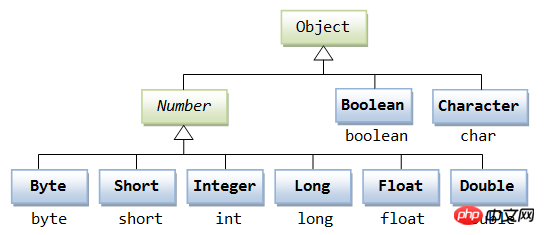This article brings you what is the packaging class in Java? An introduction to the application scenarios of Java packaging classes has certain reference value. Friends in need can refer to it. I hope it will be helpful to you.
Today I will talk about the origin of Java packaging classes, as well as the concepts and principles of automatic boxing and unboxing.
Java design originally provided 8 basic data types and 8 corresponding packaging data types. We know that Java is a high-level language for object-oriented programming, so wrapper types are exactly what is provided to solve the problem that basic data types cannot be used in object-oriented programming.
The following are the basic data types and corresponding packaging types.
| Basic data type | Packaging type |
|---|---|
| byte | Byte |
| boolean | Boolean |
| Short | |
| Character | |
| Integer | |
| Long | |
| Float | |
| Double |
The following is the inheritance structure diagram of the packaging type.

1. Collection class generics can only be packaging classes;
// 编译报错 Listlist1 = new ArrayList<>(); // 正常 List list2 = new ArrayList<>();
2. Member variables cannot have Default value;
private int status;Member variables of basic data types have default values. For example, the default value of status in the above code is 0. If 0 in the definition represents failure, there will be problems, so you can only use The wrapper class Integer has a default value of null, so there will be no default value effect.
3. Method parameters are allowed to define null values;
private static void test1(int status){
System.out.println(status);
}Looking at the above code, the method parameters define the basic data type int, so a number must be passed. Null cannot be passed. In many cases, we hope to be able to pass null, so it is more appropriate to use a packaging class in this case. There are many more application scenarios, so I won’t list them one by one. You are welcome to leave a message to discuss more application scenarios of packaging. Autoboxing and unboxingJava 5 adds an automatic boxing and unboxing mechanism to provide mutual conversion operations between basic data types and packaging types.
Autoboxing
Autoboxing means automatically converting basic data types into packaging types. Before Java 5, it was only necessary to convert basic data types into packaging types. To do this, see the code below.Integer i1 = new Integer(8); Integer i2 = Integer.valueOf(8); // 自动装箱 Integer i3 = 8;All the above three methods can be converted, but the third method failed to compile before Java 5, and the third method is also the current automatic boxing function. In addition, the first constructor method is not recommended and has been marked as deprecated. In fact, the principle of automatic boxing is to call the valueOf method of the packaging class, such as the Integer.valueOf method in the second method.
Automatic unboxing
Automatic unboxing means automatically converting the packaging type into a basic data type. Contrary to automatic boxing, it is easy to understand when it is installed and unpacked. .// 自动拆箱 int i4 = i3; int i5 = i3.intValue();Continuing the above example, assigning i3 to i4 is the automatic unboxing function. The principle of automatic boxing is to call the xxValue method of the packaging class, such as the intValue method of Integer in i5. Automatic boxing and unboxing are not only reflected in the above examples, but can also be automatically boxed and unboxed when the method receives parameters and the object sets parameters.
The above is the detailed content of What are wrapper classes in Java? Introduction to application scenarios of Java packaging classes. For more information, please follow other related articles on the PHP Chinese website!